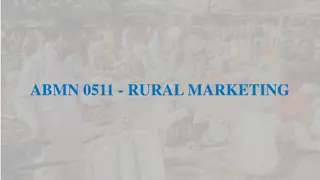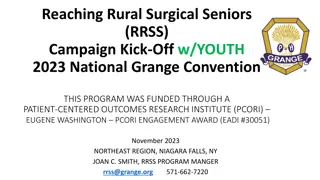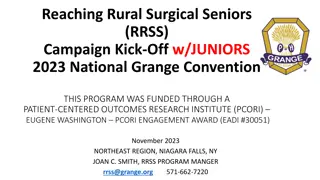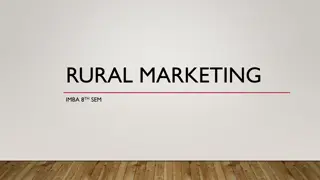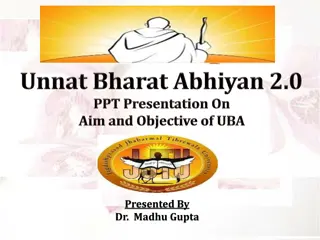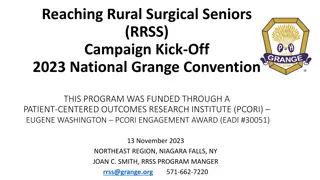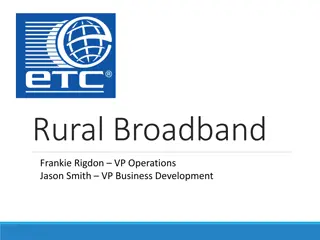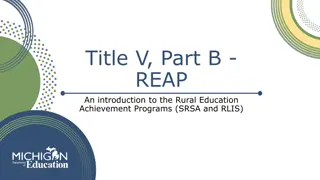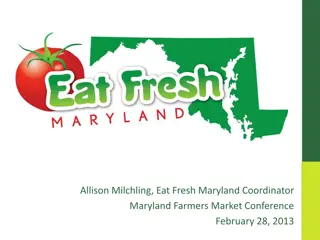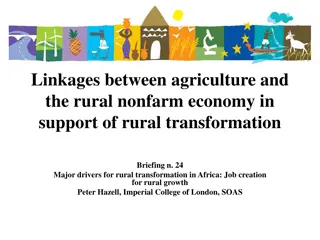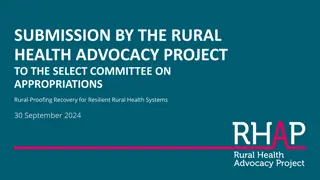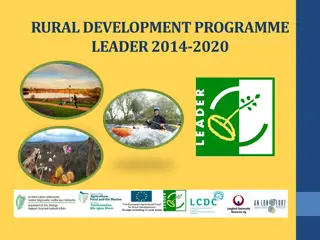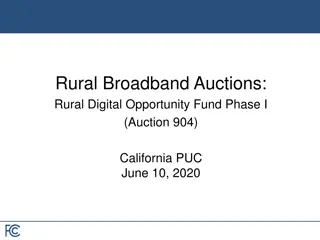Challenges and Initiatives in Rural Maryland
RURAL MARYLAND COUNCIL, an independent state agency, focuses on improving rural residents' quality of life. It addresses challenges like high unemployment rates, lack of transportation and internet access, health care provider shortages, and regulatory changes in agriculture. By convening rural leaders, the council identifies and implements solutions to uplift rural communities. The population distribution in Maryland, with a notable rural population, illustrates the need for targeted development efforts in these areas.
Download Presentation

Please find below an Image/Link to download the presentation.
The content on the website is provided AS IS for your information and personal use only. It may not be sold, licensed, or shared on other websites without obtaining consent from the author.If you encounter any issues during the download, it is possible that the publisher has removed the file from their server.
You are allowed to download the files provided on this website for personal or commercial use, subject to the condition that they are used lawfully. All files are the property of their respective owners.
The content on the website is provided AS IS for your information and personal use only. It may not be sold, licensed, or shared on other websites without obtaining consent from the author.
E N D
Presentation Transcript
Charlotte Davis Executive Director RURAL MARYLAND COUNCIL Rural.maryland.gov
AUTHORIZATION An independent state agency housed under Maryland Department of Agriculture Authorization under the Agriculture Act of 2014 regarding the National Rural Development Partnership and State Rural Development Councils First established in 1993 by Governor s Executive Order. Formally established in Maryland Statute in 1995 (Economic Development Article, Sec. 13- 401)
MISSION Serves as a partnership of federal, state and local governments, together with the private sector, to improve the quality of life of all citizens of rural Maryland. The only entity in state government specifically designed to convene rural leaders across the state and across disciplines to identify economic development challenges common to rural areas and to develop and implement realistic, workable solutions.
CHALLENGES IN MDS RURAL AREAS Higher Unemployment rates in rural Overall, the rural unemployment rate is 7.98%. The State s overall unemployment rate is 6.7%. The suburban/urban rate is 6.48%. Subtracting out the City of Baltimore, the suburban rate is even lower at 5.86%. Somerset Co (10.8%) and Dorchester (10.5%) both have the highest unemployment rates, not only among the rural areas, but in the State.
OTHER CHALLENGES Lack of transportation options Lack of access to high speed internet Health care provider shortages in rural areas Higher rates of obesity, smoking and drinking Care for stroke patients is an issue Regulatory changes in agriculture Lower rates of education attainment beyond high school
RURAL MARYLAND POPULATION 2010 Population Urban Baltimore City Suburban Montgomery County Prince George s County Baltimore County Anne Arundel County Howard County Total Suburban 620,961 971,777 863,420 805,029 537,656 287,085 3,464,967 5,773,552 Rural Harford County Frederick County Carroll County Washington County Charles County St. Mary s County Cecil County Wicomico County Calvert County 244,826 233,385 167,134 147,430 146,551 105,151 101,108 98,733 88,737 Total Maryland Allegany County 75,087 Worcester County Queen Anne s County Talbot County Caroline County Dorchester County Garrett County Somerset County Kent County Total Rural 51,454 47,798 37,782 33,066 32,618 30,097 26,470 20,197 1,687,624
MASS POPULATION TOTAL Barnstable County Barnstable County Berkshire County Berkshire County Bristol County Dukes County Dukes County Essex County Franklin County Franklin County Hampden County Hampshire County Hampshire County Middlesex County Nantucket County Nantucket County Norfolk County Plymouth County Suffolk County Worcester County 6,349,097 222,230 222,230 134,953 134,953 534,678 14,987 14,987 723,419 71,535 71,535 456,228 152,251 152,251 1,465,396 9,520 9,520 650,308 472,822 689,807 750,963
DENSITY Massachusetts Total population considered rural (million) 1.9 Percent of population considered rural: 30.6 Percent of land area considered rural: 79.5 Population density (people/sq mile) 839.4 Maryland Total population considered rural: 1.6 Percent of population considered rural: 25 Percent of land area considered rural: 75 Population density (people/sq mile): 594.8 Both states are considered heavily urbanized
MASS RURAL CHALLENGES The Patrick Administration and the legislature, in FY13, commissioned the Rural Access Commission to address the distinct needs of rural communities and to uphold the Commonwealth s commitment to supporting the success of every individual and family in the state. http://www.mass.gov/eohhs/docs/eohhs/rural-services-commission-report.pdf Priority areas: Increase access to transportation Develop an enhanced and coordinated state infrastructure that identify and address rural workforce needs Implement data-driven and evidenced based strategies to address health care worker shortage in rural communities Address Family Child Care Provider shortage for children in state funded slots Expand broadband access to rural communities and service providers
MA/MD AGRICULTURE Massachusetts Top Agriculture Products 1. Greenhouse/nursery 2. Cranberries 3. Dairy products 4. Apples 5. Aquaculture Number of Farms 7,700 Land in Farms 517,800 acres Average Farm Size 67 acres Maryland Top Agriculture Products 1. Poultry 2. Corn and soybeans 3. Dairy products and beef 4. Greenhouse/nursery 5. Aquaculture Number of Farms 12,800 Land in Farms 2 million acres Average Farm Size 160 acres
CHALLENGES TO MD RURAL GOVERNMENTS Population/Density Lower returns on investment Greater need for state subsidies State Government Representation Partisan Considerations
STATE GOVERNMENT REPRESENTATION In 1962, Baker V. Carr, the U.S. Supreme Court formulated the famous "one person, one vote" standard. The case pertained to legislative redistricting. The Court held that each individual had to be weighted equally in legislative apportionment The Court decided that in states with bicameral legislatures both houses had to be apportioned on this standard, voiding the provision which had provided for two state senators from each county. This re-apportionment increased the political power of urban areas and reduced the influence of more rural areas.
PARTISAN As of January 8, 2014, the 47-member Senate has 35 Democrats(74%) and 12 Republicans (25%) although the recent elections brought in more Republicans Not enough Republicans to sustain the Governor s veto Cannot sustain a filibuster The 141-member House of Delegates includes 98 Democrats (69.5%), and 43 Republicans (30.5%). All State-wide office holders are currently Democrats although a new Republican Governor will take office in January 2015 (only second time since the 60s) However, the past election saw high turnout of rural voters, while suburban and urban voters mainly stayed home. Record low turnout of 39% in suburban Montgomery County Loss of moderate Democrats and Republicans
STRATEGIES Create coalitions with other organizations and individuals Reach out to suburban and urban counterparts on shared interests rural can t go it alone Focus on parity and fairness
RMCS ADVOCACY ROLE Strategic assessment of council members showed that overwhelmingly members wanted the council to have an advocacy role Develop a list of budget and policy priorities Host an advocacy day Host an informal breakfast for new rural legislators Draft and support legislation Testify before legislative committees Work with the Legislature to direct funding to rural areas Help support the Rural Caucus
RMC PROGRAMS Administer the Maryland Agricultural Education and Rural Development Assistance Fund (MAEFDAF) which distributes small grants to rural-serving nonprofits FY 15, RMC awarded $170,000 to 17 organizations Administer a second Fund that aims to increase standards of living in rural areas to meet statewide averages Focus on Regional Councils, Entrepreneurship, Infrastructure, MAERDAF and Health Care Currently unfunded
RMC RESEARCH Recently completed a youth assessment in the Upper Shore area Surveyed middle and high school students about their perceptions of their communities 58% rate their community as an above average to excellent place to live as a young person. 51% picture themselves living in their hometown area in the future, if quality career or business opportunities are available. 69% feel their community is a good place to raise a family, while 57% feel there are better career opportunities available elsewhere. 47% of youth surveyed are interested in owning their own business in the future. 76% of youth surveyed said that they have never been asked by an adult to become involved in improving their community, while 74% said they would volunteer if asked.
RMC YOUTH ASSESSMENT AND ENGAGEMENT The findings of this project will provide information to community leaders to encourage them to build upon the too often untapped involvement and energy of young people in socio-economic and business planning strategies. Community leaders will be equipped to take direct actions to engage and cultivate the full potential of youth populations. Utilizing the information obtained from this project will create goals for youth engagement, retain and attract young adults and families to our region.
RURAL WHITE PAPER RECOMMENDATIONS Create a State Office of Rural Policy that would function as a research and policy clearinghouse Where is this office housed? RMC has been housed in DHCH, DBED and MDA Encourage, facilitate and support regional collaborations to increase housing affordability RMC is organizing regionally in the rural areas to determine community development needs Have seen that we have affordable and adequate housing stock, but not quality
STATE RURAL DEVELOPMENT COUNCILS Twenty-eight federally recognized councils Guiding Principles: Equal Standing of all partners Commitment to the grassroots Flexibility one size does NOT fit all Creative/collaborative solutions Partnerships Focus on enabling rural communities to achieve their goals and objectives
RURAL ISSUES CAN BE OVERWHELMING Cuts across so many policy areas Education Agriculture Economic Development Community Development Land Use Health care Infrastructure
RURAL VS. URBAN In MD, we have found that our rural and urban areas share the same challenges It s just the solutions are different! Not one size fits all What works in suburban Bethesda, often won t work in Oakland Example: Complete Streets policy
RURAL MATTERS! Food, fiber and fuel Local food has become increasingly more in demand Need to ensure access to affordable land Grow food, not houses Energy production occurs in rural areas Renewable energy facilities such as wind and solar Natural gas production and export Wood energy
Charlotte Davis Executive Director Rural Maryland Council 50 Harry S. Truman Parkway Annapolis, Maryland 21401 (410) 841-5774 Charlotte.davis@maryland.gov

 undefined
undefined









